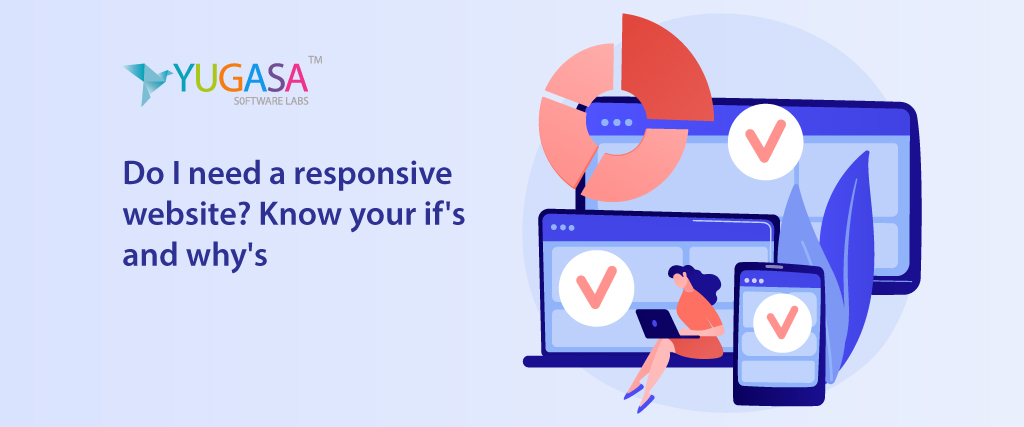Responsive Web Designs: Mobile traffic has advanced since 2015, with the number of smartphone subscribers worldwide reaching 2 billion in 2016. About 79% of all internet searches currently come from mobile devices.
On April 21, 2015, Google introduced a new search engine algorithm that included the user-friendliness of a website as one of the rating criteria.
This growth in mobile devices used to browse the web is due to Google’s Mobilegeddon and AMP.
In the search results, this mobile-friendly ranking algorithm was developed to give such mobile-friendly sites a lift.
Alternatively, in their search engine rankings, websites that were not smartphone-friendly saw a drop.
The AMP was later announced by Google on October 7, 2015, to provide the best smartphone interface to internet users.
These two are the key reasons why, nowadays, responsive web designs have become a common topic for web creation.
So, what are Responsive Websites?
A responsive website is one with a fluid and versatile interface that helps it to adapt according to the different sizes of the screen.
Therefore, a responsive web design essentially means a website design that reacts and resizes itself to see if it is a desktop computer, laptop, mobile, or tablet, based on the platform being used.
The key purpose of this web creation is to make website content differently based on the platform or screen size used to display it, meaning that to view content, website users would not need to manually resize it.
Having a responsive web design has many advantages to deliver when you add all those stuff together.
Several aspects can lead to the rating and development of your website, from having a beneficial effect on your SEO and retention rates to optimizing user experience.
So let us study the benefits in a little more detail.
1. Improved SEO
Improved search engine rankings are one of the key benefits of creating a responsive site interface.
As one of the determiners of their rank in the search engine rankings, Google takes into account website’s responsiveness.
This only means that it will immediately be put lower in the search engine rankings because the website is not responsive.
2. Enhanced User-Experience – Responsive Web Designs
A responsive website design enables users to have a good experience irrespective of the platform they are using.
If your website users find that your website scales and reacts easily to size shifts and can navigate both menus and buttons, they will spend a lot of time on it.
However, if they find it challenging to manage and are required to pinch and zoom material endlessly, they will not linger any longer.
3. Better traffic
Traffic figures show that almost 79% of all web traffic worldwide comes from mobile devices. Currently, more than half of the global Internet traffic accounts for this.
This further highlights how it is constantly important to have a website that operates correctly on all mobile devices.
You would automatically note a rise in the number of your website users and also the time they spend on your website with the introduction of a responsive interface.
4. Faster loading times for Websites – Responsive Web Designs
People prefer to leave certain websites that take longer than three seconds to finish loading content, according to statistics.
Fortunately, websites with a responsive architecture tend to load even quicker regardless of the computer used to view them, as they are designed with responsive images and fluid grids.
This makes it easy to load web pages faster, which in turn has a significant positive effect on the length of visits to the website.
5. Better conversion rates
Research shows that the overall conversion rate for smartphones is around 64 percent higher than the conversion rate for desktops.
From this, it is very easy to see that the secret to a better conversion rate is to build a responsive website with a strong user interface.
When your visitors invest more time on your website, they generate trust that leads to better rates of conversion.
And as a matter of fact, users tend to get annoyed when they are forced to subscribe to a site, whether it’s subscribing to emails or making a transaction, as a matter of reality.
6. Simpler analytics – Responsive Web Designs
You need to know how your customers communicate with your website to make better choices about how to optimize your website.
If you have two separate versions of your website, it ensures multiple conversion funnels, routes, and redirects are needed for your developers to know critical website metrics, such as where your traffic comes from and how your visitors communicate with your content.
On the opposite, for a sensitive blog, to know how the platform and content work, you would not need to provide details from numerous surveys.
7. Easier maintenance
It needs extra testing and support to provide a different desktop and smartphone website.
Your development team would certainly have to split time and money to handle them efficiently because you have two separate iterations of your website.
Your production team will spend less time on maintenance with a responsive website and have more time to work on other critical activities such as marketing and product or content development.
Concluding,
There are a lot more advantages offered by a responsive website than just these, but enough of these has already been mentioned to tell you the need for it. But sometimes you lack the manpower to build a website like that.
No worries, we got your back! Yugasa is the one-stop-shop for all your needs regarding the best responsive websites you can ever dream of. So what are you waiting for? Book a call today!
Read More: ALL ABOUT RESPONSIVE WEB DESIGNS AND WHY IS IT REQUIRED























